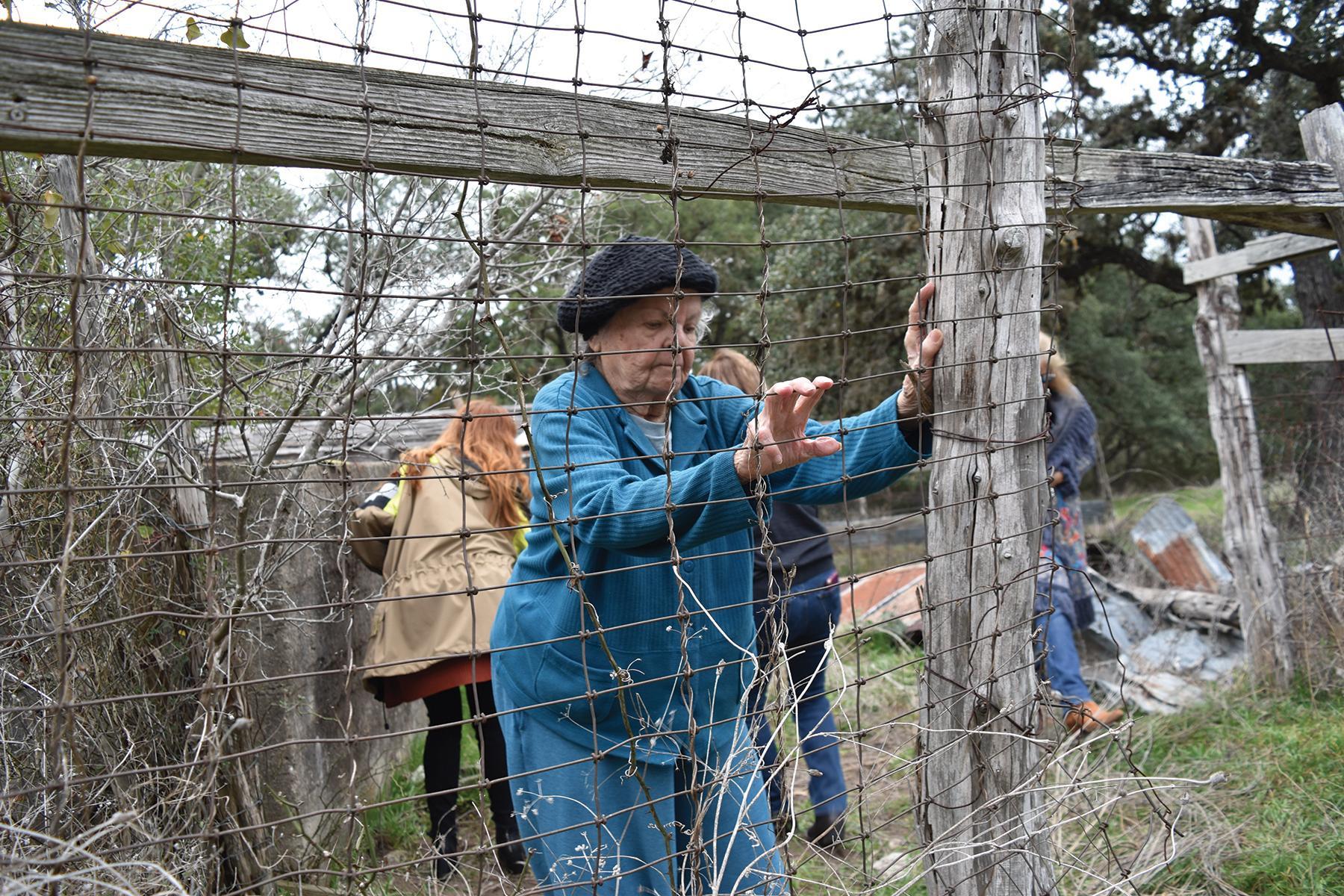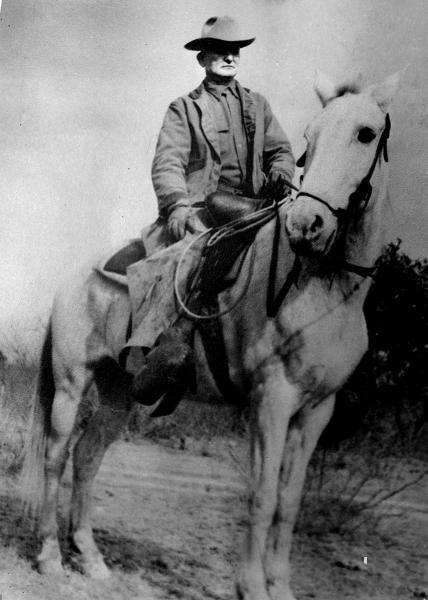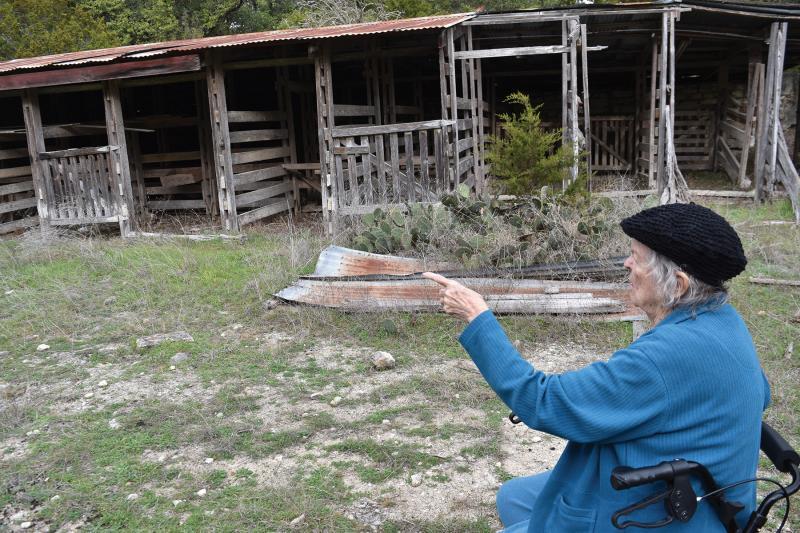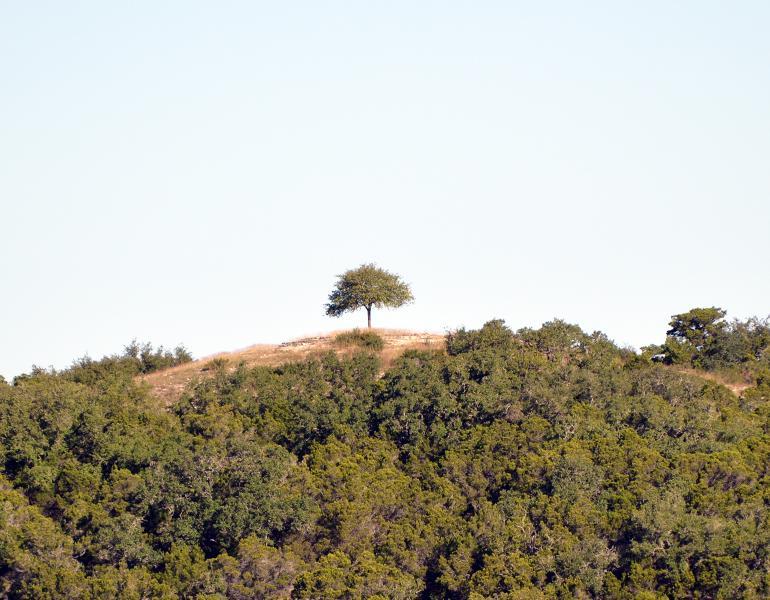
Lera Lumbley is living history of El Rancho Cima. Lumbley spent her childhood on the property, before the Boys Scouts purchased it in the 1950s, when it was still called Donaldson Ranch and owned by her father. She recently revisited the property and inspected the grounds for remnants of her childhood, like the fence her father built. Photos by Gary Zupancic
Reliving the history of El Rancho Cima
There are many ways to look at history. Scientists calculate the age of the universe. The same goes with planet earth, man and so much more. Historians look at the political and social realities and their effects of each era on future generations. But one facet of history tends to get overlooked, the one that should mean the most to us. The first hand telling of our history, especially the local accounts.
Lera Lumbley is 99 years old, but very lucid when it comes to remembering her time growing up in Hays County.
She is currently a Round Rock resident, but she grew up on El Rancho Cima before the Boys Scouts purchased the property in the 1950s. Then it was called Donaldson Ranch, “named after Mr. Donaldson who owned the ranch before us,” said Lumbley. The ex-Boy Scout property and soon to be regional park and nature conservancy has a lot of personal history and meaning to her.
The house she grew up in, only in the summers, was torn down to the foundation then rebuilt on top of it. She described the features of the house in detail, down to the location of the outhouse and the piano.
The other nine months of year, her family lived in a rented house in San Marcos. She was proud about attending school in San Marcos, including the Baptist Academy and Southwest Texas Teacher College — now Texas State University.
Lumbley eventually left the area and attended Columbia University in New York City. While at Columbia, one of her jobs that she worked while attending school was under Manhattan Project physicist George B. Pegram. Columbia was a magnet for a lot of celebrities of the time. There she met many including senators and the actress Shelly Winters.

Jack Tally, Lumbley's father, on his favorite horse Old Pat.
Lumbley eventually married, traveled and taught art in schools for 34 years around Texas and New Mexico and even at St. Johns in the Virgin Islands. Her life was very different from growing up on the Blanco River. But being in the very rural place she grew up, miles from anywhere, memories of the ranch came fast and easy. The memory of her family and taking care of animals and working the ranch was close at hand.
Lumbley remembers her father Jack Talley as a dedicated rancher. He kept up with research on farming and animal husbandry techniques from Texas A&M, watched for common livestock disease and learned how to treat it when it did pop up. After all, having 200 head of sheep, 1,300 goats, 1,100 head of cattle and 12 horses was a job you had to keep up with. If there were buzzards, “he’d pick up the animal and bring it home (on horseback)…and tend to it overnight.” He kept records on the animals as to what mares were bred with what bull. He diligently relied on the latest information provided by A&M, having attended there for two years.
Every aspect of the property holds memories for Lumbley — the holding pen next to the cement cistern with an entrance just over 5 foot 3 inches, exactly her father’s height. Even the cement cistern that held water for animal troughs held memories — her pet goat Billy would walk the cement top of the cistern, according to Lumbley.

Lumbley points to the old goat barn, that has since been turned into a stable.
“My brother ran her (Billy the goat) down and caught her. Mr.Wilborn (a neighbor) said if you catch her you can keep her.”
Her brother Fred did and gave the goat to his sister.
“He said that little goat you been playing with is a sancho (an orphan), take care of her. I came back the next summer there were two billys. She had twins that spring,” Lumbley said. “Dad built a playground for the kids to go on, a seesaw, and the kids (goats) would jump around. They would use the see-saw.”
Lumbley recalls the joy and also the work of her childhood on the ranch. One job was mixing up compounds — copper sulfate, tobacco and water — to administer to the animals to repel disease-carrying insects, which required huge paddles in a big tank.
“The paddles were 18 feet by three feet, and we would stir it…we would then fill syringes,” Lumbley recalls.
Another chore was administering vaccines to the animals.
“You had to give them to each sheep. You have to starve them for 12 hours then the vaccine for three or four hours more,” Lumbley said. “They bleated all night. It was a sleepless night.”
The times were not idyllic, though. It was the Great Depression and the times were very hard. A few poachers would steal livestock, and one neighbor would not let others on his property, not even the telephone company, delaying phone service for a while.

The top of Sentinel Peak, that Lumbley and her brother used to call "Bear Mountain."
But Lumbley recalls many good memories like learning to swim, playing on “Bear Mountain.”
“We played on Bear Mountain (now Sentinel Peak),” Lumbley said. “We took rocks and built a circle — a playhouse for me. For Fred it was a fort.”
Memories and reliving past times make history more real to those that listen. And even though it has been 80 years, Lumbley’s emotional hold on the old ranch where she grew up can be summed up in a few words: “This land was home.”
And soon, it will be home to a new natural area for all of Wimberley to enjoy — and hopefully appreciate the history of those that worked the land.











